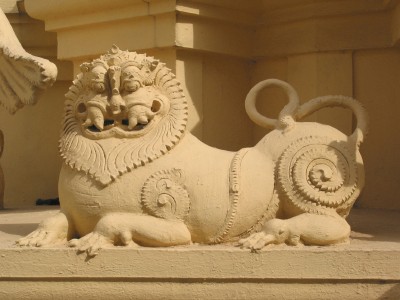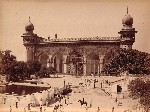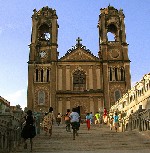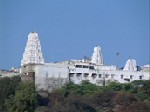Hyderabad Places Of Worship
Filed under Attractions

Hyderabad is primarily a fusion of two cultures: Hindu and Islam, and this fusion is never more apparent than the places of worship that dot this historical and beautiful city. What’s more, these religious sanctuaries hold their own in terms of aesthetic appeal as well, with some becoming architectural wonders that evoke more than religious feelings of wonder. Most of these structures have withstood the tests of time and the elements, holding out the example of peaceful co-existence of cultures then, now, and in the future generations.
Visitors should visit the following religious places regardless of their culture and religion.
Chote Hazrat Ki Dargah Masjid. Situated in Devan Devadi, the Chote Hazrat ki Dargah was made during the Asah Jahi dynasty. The place of worship itself can take a lot out of less physical people; 400 steps must be trekked before anyone can reach it. It is considered to be very sacred to Muslims, and is one of their pilgrimage places. During the 8th and 10th day of Moharram, a large number of Muslims flock here to pay their offerings.
Mecca Masjid |
|
|---|---|
 |
Of all the mosques in Hyderabad, nothing is as grand and as big as the Mecca Masjid. It was built under orders of Hyderabad’s founder, Muhammed Quli Qutub Shah in 1617 and its construction was supervised by Mir Faizullah Baig and Rangiah Choudhary. When the Mughal empire took over Hyderabad in 1687, the Mughal emperor Aurangzeb completed its construction in 1694. All in all, it took 77 years for the mosque to become what it is now, today. It can be found just 100 yards away from another historic Hyderabad landmark, the Charminar. |
The name came about because legend has it that Muhammed Quli commissioned some of the bricks in the walls of its main arch from Mecca. The great hall of the mosque is 75 feet high, 220 feet wide, and its length is 180 feet. It is supported by fifteen arches; three walls of the hall are supported by five arches each. At any given time, the mosque can hold 10,000 faithful worshippers. All in all, it is said that 8,000 workers were needed to construct the whole edifice. The king himself laid down the foundation stone for the mosque, after finding no one else who never missed his prayers.
A quiet moment can be had in the mad-made pond that holds clear, blue water. It is said that anyone who sits in the seating arrangements in the edge of the pond will visit Hyderabad again. The arches on mosque are also adorned with sermons from the Quran. A room in the courtyard houses ancient and holy relics and it is said that the hair of the prophet Mohammed can be found there.
St. Joseph’s Cathedral |
|
|---|---|
 |
Christianity, while one of the four major religions found in Hyderabad, can be considered relatively a minority in Hyderabad. Even so, it is represented quite nicely by St. Joseph’s Cathedral located at Gunfoundry, north of Abids and King Koti, in Hyderabad. |
Currently the cathedral of the Archdiocese of Hyderabad, St. Joseph’s Cathedral was established in 1820, with the construction of the present structure begun in 1869. The foundation was laid on the 18th of March, 1870 and was finally completed in 1875. The church’s facade and the bell towers–whose bells were imported from Italy–were completed in 1891. The bells themselves were installed in 1892 and they can be tuned in such a way that multiple hymns can be played from them.
The central hall can accommodate 500 people at a time. There is an alcove located inside the Cathedral where one can find an imitation of Michelangelo’s Pieta. The belfry affords a wonderful view of the city but getting up there is a scary endeavour. Once there, however, the view from the belfry is absolutely breathtaking.
Birla Mandir |
|
|---|---|
 |
Entirely made out of marble a quarter century ago or so, the Birla Mandir stands in all its splendor atop Kala Pahad, a small hillock in Hyderabad. The temple is dedicated to Lor Venkatsewara, also known as Balaji in the north. It overlooks the waters of Hussain Sagar lake and offers a wonderful view of both Hyderabad and Secunderabad. |
The craftsmen who made Birla Mandir have carved their excellence in the intricate carvings of the temple, the ceiling, and the mythological figures one can find in the temple. Scenes from Indian epics such as the Mahabharata and Ramayana and finely realized in pure white marble. All in all, the temple is a beautiful marriage of both north and south architecture.
Yadagirigutta Temple |
|
|---|---|
 |
Legend has it that a sage named Yadavarishi, the son of the great sage Rishyasrunga, did penance and meditation in a cave and asked for the blessings of Lord Narasimha, an incarnation of the Hindu deity Lord Vishnu. So pleased was Lord Narasimha to Yadavarishi that he appeared to him in five different forms: Jwala, Yogananda, Lakshminarasimha, Gandabherunda, and Ugra. The legend goes that the first form was too intense and fiery (it was Lord Narasimha as a fire) that it was too much for the yogi, so Narasimha adopted the second, more peaceful, form (Lord Narasimha in a Yoga posture with open palms on the knees). This still didn’t satisfy the yogi though and wanted to see him with his counterpart, the goddess Lakshmi, so Narasimha appeared with the goddess on his lap. The place where all this was supposed to have taken place was a natural cavern atop a hill. The temple was then built in the same area. Read more about Yadagirigutta Temple. |


Comments